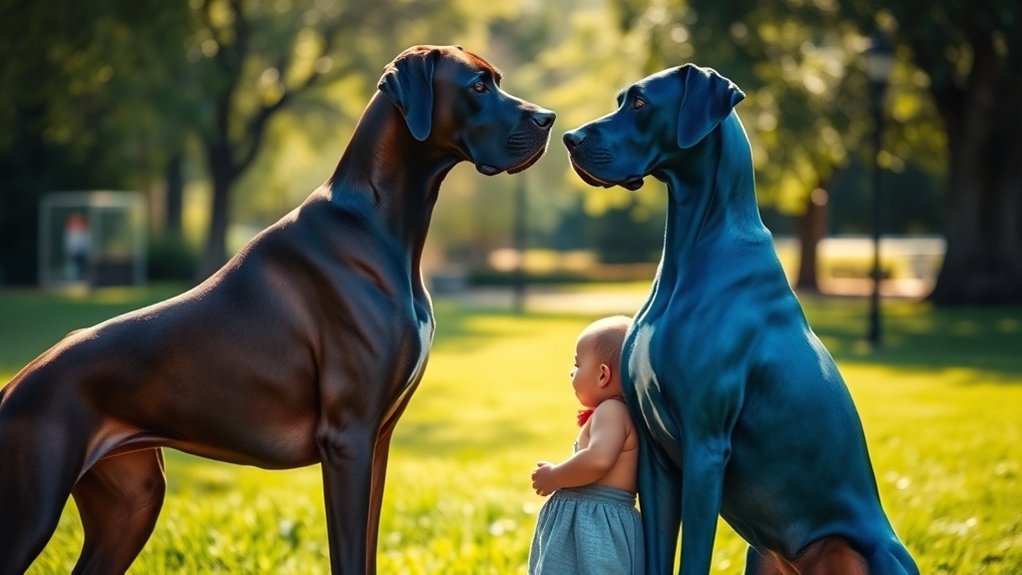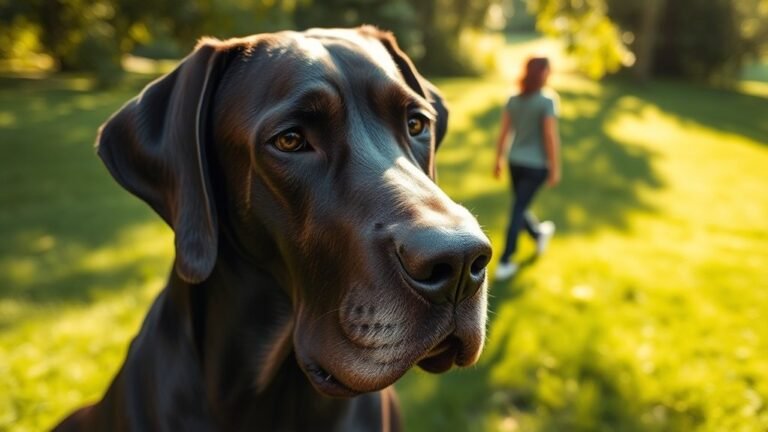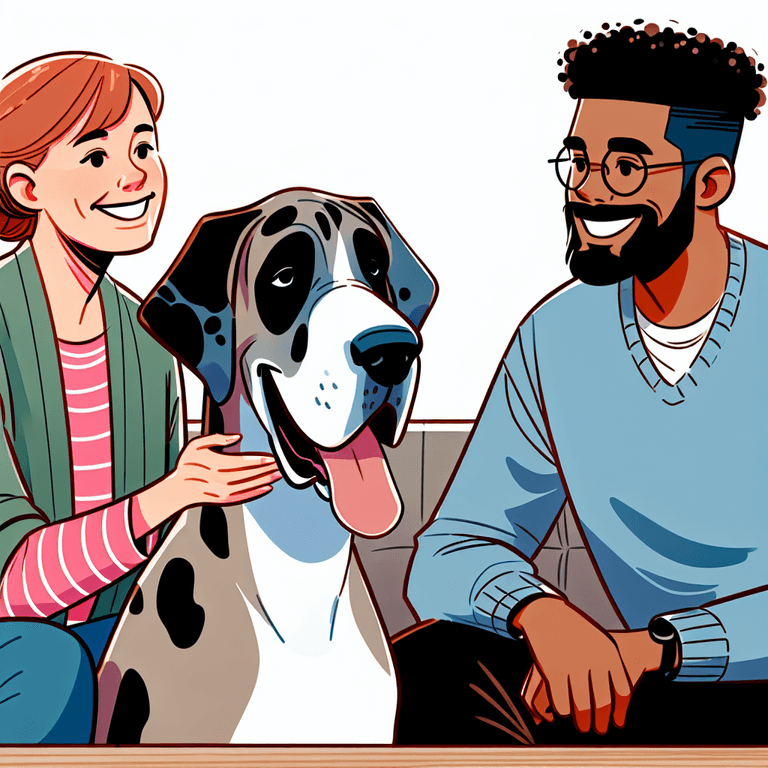My Loyalty Walks Beside You, Step for Giant Step.

Great Danes & Loyalty
Woof! Let me tell you about us, Great Danes, and why we’re basically the best dogs ever.
We’re pretty much the definition of loyalty on four legs. Sure, we might be the size of small horses, but we’re really just gentle giants who want nothing more than to be your best buddy. We’ll follow you around the house like furry shadows, even though we sometimes knock things over with our waggy tails. Oops!
Here’s the thing about us – we think we’re lap dogs. I know, I know, we weigh more than some humans, but that couch looks pretty comfy, and your lap seems like the perfect spot for a nap. Don’t mind the fact that my paws might dangle off both sides.
We take our job as family protectors seriously, though we’re more likely to slobber on an intruder than actually scare them away. Our bark is pretty impressive, but honestly, we’re hoping you’ll just invite everyone in for snacks. Speaking of snacks, got any?
Training us isn’t too hard because we really want to make you happy. Just remember that when you’re teaching us to sit, we need a moment to figure out where exactly we’re supposed to put all these long legs. It’s like trying to fold a giraffe.
We need our daily walks to stay healthy, and they also give us a chance to show off how awesome we are to all the other dogs in the neighborhood. They’re definitely jealous of our majestic stride.
The bottom line? We’re loyal, loving, and slightly clumsy giants who want to be part of your pack. And maybe share your dinner.
The Gentle Giant: Understanding Great Dane Temperament
Sure, I’m pretty huge – I can practically see over your kitchen counter without even trying. But here’s the thing that might surprise you: I’ll absolutely try to squeeze onto your couch and maybe even your lap, whether you like it or not.
My ancestors were tough hunting and guard dogs, but honestly? I’d rather play fetch or take a nice nap in a sunny spot. I’m way more interested in being your best friend than scaring anyone away. In fact, I’m probably more scared of that vacuum cleaner than any burglar would be of me.
Here’s what I love most: hanging out with my family. I’m super social and love meeting new people. Kids? They’re awesome – though sometimes I forget how big I am and might accidentally knock them over with my enthusiastic tail wagging. Sorry about that!
I’m pretty chill most of the time, but don’t let my calm attitude fool you. I can be silly and playful, too. Want to see something funny? Watch me try to fit through a dog door made for normal-sized dogs. It’s comedy gold.
The best part about being me? I’m sensitive and caring, so I always know when you need a friend. I might be giant, but my heart is even bigger. Great Danes exhibit clinginess due to their protective instincts and love for human companionship.
Unwavering Loyalty: The Bond Between Great Danes and Their Owners
My Humans Are Pretty Great (But I’m Greater!)
Listen up, fellow four-legged friends! As a Great Dane, I’ve got some serious expertise when it comes to loyalty. Sure, other dogs think they’re loyal, but have they ever tried to fit their 150-pound body into their human’s lap while they’re watching TV? I didn’t think so!
My loyalty game is strong, and here’s how I show my humans just how much I care. First, I follow them everywhere – and I mean EVERYWHERE. Bathroom trips? I’m there. Kitchen visits? Right behind you, human! They call it “following,” but I prefer “professional supervision.”
My loyalty is unmatched! I follow my humans everywhere—bathroom trips and kitchen visits, always on duty as their professional supervisor!
I’m also the world’s best cuddling machine. My humans bought this thing called a “couch,” but honestly, it works much better as a dog bed that happens to fit humans, too. When I drape my giant paws over my favorite person, that’s not just cuddling – that’s a full-body hug that says “you’re mine forever!”
And talk about being alert! I notice everything. That suspicious squirrel in the yard? I see it. The delivery truck is three blocks away. My ears are on it. My humans seem to appreciate my security services, even if they don’t always understand my 2 AM bark alerts about cats walking by.
The best part is how my humans help make our bond even stronger. They play games with me (I always win), teach me cool tricks (sit is my specialty), and give me treats when I’m extra good (which is always). Effective training methods help build trust and loyalty in our relationship!
Being a Great Dane means being great at love, great at protection, and excellent at taking up the entire bed. My humans are lucky to have me!
Importance of Training and Socialization in Fostering Loyalty
Training is like going to school, except way more fun because there are treats involved. When our humans use positive reinforcement (fancy words for “give us cookies when we’re good”), we learn super fast. We’re smart cookies – pun intended!
The more our humans praise us and reward us, the more we trust them. And trust me, when a 150-pound dog trusts you completely, that’s some serious loyalty right there.
Now, socialization is essentially our version of attending parties and meeting new friends. The more places we visit as puppies, the more people we meet, and the more dogs we sniff (it’s polite in our world!), the more confident we become.
A confident Great Dane is a happy Great Dane, and a happy Great Dane is incredibly loyal. Early exposure during the sensitive period is essential for us to develop well-rounded behavior and avoid future anxiety.
Think about it – when we’re not scared of the mailman, confused by doorbells, or worried about that weird vacuum cleaner monster, we can focus on what really matters: being your best friend.
We’re naturally gentle giants, but training and socialization help us become the amazing companions we’re meant to be.
Care and Exercise: Key Factors Influencing Loyalty
Care and Exercise: What Makes Me Your Most Loyal Buddy
Hey there, humans! Let me tell you something essential about us, Great Danes, and why we stick by your side like glue. It all comes down to two magic words: care and exercise.
First, let’s talk about exercise. I know what you’re thinking – “But you’re huge! You must need to run marathons!” Wrong! Sure, I’m basically the size of a small horse, but I’m more like a gentle giant who just needs a good daily walk and some playtime.
Take me out every day, throw a ball around, and I’ll be happier than a kid in a candy store. Skip my exercise for too long, and I might get a little… creative with your favorite shoes. Trust me, you don’t want that!
Now about the care part – and by care, I mean FOOD! Keep my bowl full of the good stuff, and I’ll follow you anywhere. Good nutrition keeps my massive body running smoothly and my tail wagging at top speed.
Plus, when you take care of my health with regular vet visits, I feel awesome and ready to be your faithful sidekick. This includes monitoring weight and activity levels to ensure I stay in tip-top shape!
Here’s the secret sauce: when you give me proper exercise and take good care of me, something magical happens. We become best friends for life!
I’ll be your shadow, your protector, and your biggest fan. That’s just how us Great Danes roll – treat us right, and we’ll be loyal until the end of time.
Daily Exercise Routine
My Daily Exercise Routine – By a Great Dane
First things first – I NEED my daily walks. And when I say walks, I mean real walks, not those tiny trips around the block. My legs are longer than most people’s, so I can cover some serious ground! Teaching me to walk nicely on a leash is super crucial because nobody wants a 150-pound dog dragging them down the street like a sled dog.
My brain is just as big as my body, so I get bored really easily. When I’m bored, I might decide your couch looks like a giant chew toy or that digging holes in the backyard is the perfect hobby. Trust me, you don’t want that! Running around, playing fetch, or learning new tricks keeps my mind busy and my paws out of trouble.
I love mixing things up, too. Some days we can go for long walks, other days maybe we can play in the yard or go to the dog park where I can show off how I’m taller than all the other dogs.
The more fun we have together, the stronger our friendship becomes. When you keep me active and entertained, I’m the most loyal, loving giant you’ll ever meet. Regular daily exercise not only keeps me happy but also contributes to my overall health and well-being.
Plus, I’ll be healthier and happier, which means more years of me trying to sit on your lap! Let’s make exercise time the best part of our day together!
Nutrition and Health
Sure, my humans think exercise is super important (and boy, do I love a good romp in the yard), but let me bark some truth at you – what goes in my food bowl is just as crucial for keeping this magnificent body running smoothly.
Here’s what every Great Dane needs to know about chow time:
1. Figure out what makes your tail wag at dinner time! Some of us love chicken, others go crazy for fish.
Life’s too short for boring kibble, so make sure your humans know your favorites.
2. Demand the good stuff! Not all dog food is created equal, and when you’re as majestic as we are, you deserve high-quality grub that gives you all the nutrients your giant body needs.
3. Don’t forget the extras! Sometimes we need special vitamins, especially for our joints. Glucosamine and chondroitin are essential for keeping our cartilage healthy and supporting our active lifestyle.
When you’re this tall and awesome, your knees work pretty hard carrying all this greatness around.
4. Keep an eye on the scale (even though we look fantastic at any size). Extra weight can cause problems for us big dogs, and nobody wants achy joints slowing down their zoomies.
Health Considerations and Their Impact on Behavior
Hey there, human friends! Let me tell you about something super important – how my health affects my mood and behavior. Trust me, when this giant body of mine isn’t feeling good, you’ll definitely know about it!
So here’s the deal – us Great Danes can get some pretty uncomfortable health problems. Hip dysplasia makes my hips hurt like crazy, and don’t even get me started on bloat! When my tummy gets all twisted up, I feel absolutely terrible.
And when I’m in pain? Well, let’s say I mightn’t be my usual sweet, goofy self. I might get grumpy or want to hide in my favorite corner instead of playing fetch.
That’s why I really need you humans to keep an eye on me! When you catch problems early, you can help me feel better faster. Regular trips to the vet (even though I’m not crazy about that cold examination table) and good food that doesn’t upset my sensitive stomach make a huge difference. Maintaining a healthy weight is crucial to avoiding hip dysplasia and other joint issues.
I need you humans to watch out for me! Early detection makes a big difference in my health and happiness.
When I’m healthy and feeling good, I’m the best dog ever – playful, loyal, and ready to give you those famous Great Dane hugs that might accidentally knock you over.
But hey, that’s just how we show love!
Interactions With Family and Other Pets: Loyalty in Action
How I Show My Family I Love Them (And Other Pets Too!)
Woof! Let me tell you about how us Great Danes are basically the best family members ever. I mean, I’m not bragging or anything, but we’re pretty awesome at this whole loyalty thing.
First off, I’m like a furry security guard who never takes a day off. When someone comes to the door, you bet I’m going to let everyone know! My deep bark could probably wake up the neighbors three houses down. Sure, sometimes it’s just the mailman, but hey – better safe than sorry, right? I take protecting my humans very seriously, even if they sometimes tell me to “quiet down” when I’m just doing my job.
I’m also basically a professional hugger, except I weigh about 150 pounds and sometimes forget that not everyone wants a lap dog this size. When my family comes home, I get so excited that I might accidentally knock over a small child or two while trying to give everyone welcome-home kisses. My tail is like a weapon of mass affection – it can clear a coffee table in seconds!
Living with other pets is pretty cool, too. I’ve learned that cats think they’re the boss (spoiler alert: they usually are), and smaller dogs sometimes have Napoleon complexes. But I’m good at sharing my space, even if I accidentally sit on the family cat sometimes. It’s not my fault she’s so tiny, and I’m so… not tiny. Great Danes have low aggression thresholds, making them generally good with other dogs and pets when properly socialized.
The best part about being in a family is playtime! I love playing fetch, even though I sometimes get distracted halfway through and forget to bring the ball back. And wrestling with my human siblings is the best, even if mom keeps yelling about “gentle” and “indoor voice.” What’s an indoor voice anyway?
Trust me, once you have a Great Dane in your family, you’ll never want anything else. We’re like gentle giants with hearts bigger than our massive paws!
Final Thoughts
First off, let me say that we Great Danes are pretty awesome. We’re like the friendly skyscrapers of the dog world! When you train us and let us hang out with other dogs and people, we become your best buddy for life. Trust me, once you earn our friendship, you’re stuck with us forever – and I mean that in the best way possible.
Now, about this whole loyalty thing – we’ve got it down to an art form. We don’t just love you; we REALLY love you. Like, follow-you-to-the-bathroom kind of love. Some might call it clingy, but we prefer “dedicated companionship.” When you’re sad, we’ll rest our giant heads on your lap (whether you want us to or not). When you’re happy, we’ll bounce around like oversized puppies, probably knocking over a few things in the process. Oops!
The secret to keeping us happy and loyal is pretty simple: give us good food, plenty of exercise, and lots of belly rubs. Oh, and maybe a couch we can secretly sleep on when you’re not looking. We promise we’ll just put our paws up there – okay, fine, maybe our whole body.
What makes us special is how we treat your family and friends like our own pack. Your kids? We’ll guard them with our lives. Your visitors? We’ll greet them with enthusiasm that might accidentally involve some jumping. Don’t worry, we’re just saying hello with our whole bodies!
Sure, we might drool on your favorite shirt or take up most of your bed, but that’s just how we show love. And honestly, life is way better when you’ve got a loyal Great Dane by your side, ready for any adventure (especially if it involves treats).
So there you have it, straight from the horse’s mouth – or should I say, the Great Dane’s mouth! We’re loyal, loving, and worth the extra-large food bills.





7 Comments